Cataracts in dogs may sometimes make a dog’s vision cloudy or steal it completely. But it doesn’t have to keep a dog from having a wonderful life. Integrative veterinarian Dr. Julie Buzby explains what a cataract is, and discusses the causes, stages, symptoms, treatment, complications, and how to help your dog adjust to being blind if it comes to it.
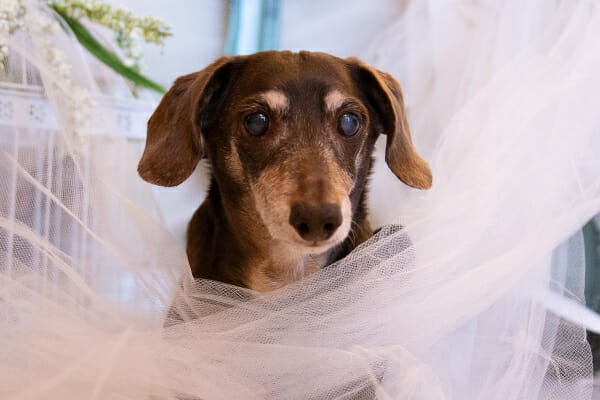
- Cataracts in dogs: One dog's story
- What are cataracts in dogs?
- What causes cataracts in dogs?
- What are the stages of cataracts in dogs?
- What are the signs of cataracts in dogs?
- Cataracts vs. nuclear sclerosis: What's the difference?
- How will my vet diagnose cataracts in dogs?
- What is the treatment for cataracts?
- Cataract surgery for dogs
- Pros and cons of cataract surgery for dogs
- Cataract treatment without surgery
- How can I help my dog who has cataracts?
- "The Best Dog Ever"
- Do you have a dog with cataracts?
Cataracts in dogs: One dog’s story
One of my veterinary colleagues was recently telling me about her parents’ Labrador Retriever mix, Clark. Although he has since passed away, she said she loves to tell his story to her clients to remind them that cataracts (or other causes of blindness) don’t have to keep a dog from enjoying life to the fullest.
Clark had a rough start to life. He and almost 400 other dogs were found living in deplorable conditions in hog barns. Shortly after the dogs were rescued, one of the vets who had volunteered her time to help care for the sick dogs was walking between a row of dogs in crates.
Suddenly, the unmistakable sound of a tail thumping against the side of a cage caught her attention. When she bent down to see the dog inside, there was Clark.
The friendly dog was completely blind due to advanced cataracts but just as sweet and happy as could be.
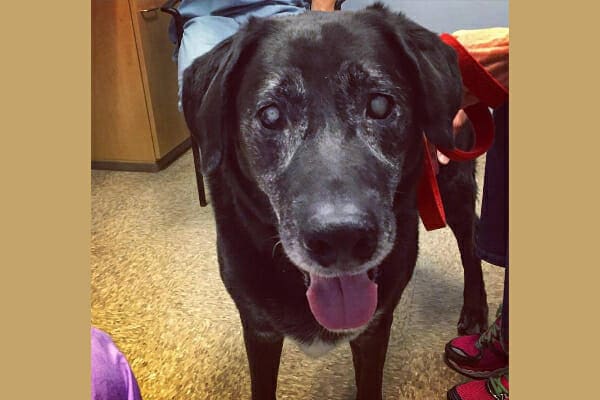
The vet wasn’t intending to take a dog home with her that day. But there was something special about Clark. She just couldn’t leave him behind. He spent the next month learning how to be an indoor dog and navigate the world from one of her friends, who happens to be a vet tech and dog foster mom extraordinaire.
Then the time came for this lovable rescue dog to find his forever family, which is where my colleague’s family comes in. For the next five years, Clark had a fantastic life. He is a shining example of how cataracts don’t necessarily diminish a dog’s joy. More on that after we get into the nitty gritty on cataracts in dogs.
What are cataracts in dogs?
To understand cataracts in dogs, it helps to understand how the eye works. Inside each eye is a clear disc called the lens. Much like a lens in a camera, it focuses light onto the retina. Specialized cells in the retina translate the light into a nerve signal which travels to the brain. The brain then converts the signal into the image that we perceive.
But what do you think would happen if the lens suddenly became cloudy or opaque? Imagine what happens if you leave the lens cap on your camera or the lens becomes covered in specks of dirt. This is sort of like what happens in cataracts in dogs.
You see, cataracts cause a clear lens to become progressively more opaque. Now the beam of light carrying the image information can’t get through the lens properly to hit the retina. This reduces or eliminates a dog’s ability to see out of that eye.
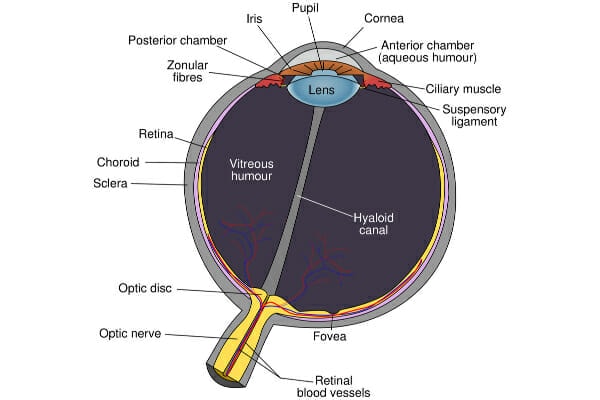
What causes cataracts in dogs?
There are a variety of reasons that a cataract may form. Broadly speaking, the causes of cataracts in dogs are divided into primary causes (i.e. those that happen independent of any other cause) and secondary causes (i.e. those that occur as a direct result of another process).
Primary causes of cataracts in dogs
- Old age—When dogs age, they may not be able to restore old or damaged lens protein fibers as quickly as they used to. This may lead to cataract development.
- Genetics— Cataracts may be hereditary in some dog breeds. Genetic testing is available for some breeds to identify carriers of the genes linked to hereditary cataract formation. The most commonly affected breeds include:
- Cocker Spaniels
- Boston Terriers
- Poodles
- Bichon Frises
- French Bulldogs
- Labrador Retrievers
Secondary causes of cataracts in dogs
- Eye injury—Damage to lens fibers from trauma, infection, toxins, drugs, or other situations may lead to cataract formation.
- Diabetes mellitus—This is the second most common cause of cataracts in dogs. Diabetic dogs may have excess levels of glucose in their blood. When glucose gets into the lens, an enzyme converts the glucose into sorbitol. This large molecule pulls water into the lens, damaging the lens fibers. In some cases, diabetic cataracts can show up as soon as 24 hours from the time of diagnosis. Other times they occur later on in the disease process. Regulating diabetes is key to delaying or preventing the formation of cataracts in diabetic dogs.
- Eye disease—Progressive Retinal Atrophy (PRA) or glaucoma may lead to cataracts in dogs.
- Nutritional deficiencies—Certain amino acid imbalances have been linked to cataract formation.
What are the stages of cataracts in dogs?
There are four different stages for canine cataracts, based on severity. Cataracts will sometimes progress through all four stages. Other times they will stop at one particular stage. Dogs may also have different stages of cataracts in each eye, or have a cataract in one eye and not the other.
- Incipient cataract—This type of cataract involves only 10 to 15% of the lens. It typically doesn’t cause any vision loss.
- Immature cataract—When the cataract takes up greater than 15% of the lens, it is classified as an immature cataract. Vision may be mildly or moderately impacted.
- Mature cataract—This type of cataract affects the entire lens, completely blocking light from reaching the retina. Vision loss is near complete, though the dog may be able to see some shadows if the retina is healthy.
- Hypermature cataract—Sometimes the body will try to reabsorb a mature cataract. As the lens of the eye liquefies, it shrinks and leaves behind a wrinkled lens capsule. If the retina is healthy, some dogs can regain some vision in the affected eye. It is possible for immature cataracts to skip the mature phase and go straight to the hypermature stage.

What are the signs of cataracts in dogs?
Depending on the cause of the cataracts, they may affect one or both eyes. Most incipient or early immature cataracts are difficult to see when just looking at your dog’s eye.
Affected dogs might not show any signs at all. As a result, many dog parents don’t realize a cataract is present until their veterinarian finds it on a routine physical exam.
As a cataract progresses to late immature, mature, or hypermature, it is much easier to see. Typically, you will notice that your dog’s eye looks cloudy or white in the area right behind the pupil where the lens sits.
This is especially evident if you are in a dark room where your dog’s pupil will naturally dilate. If you then use a penlight or flashlight to look at your dog’s eyes, you may see the cataract. As your dog’s vision decreases, you may also notice your dog bumping into things or acting tentatively in new situations.
Note: I don’t advise routinely shining a bright light into your dog’s eyes to check for cataracts. Just like our eyes, dogs’ eyes are sensitive to direct bright light. If you are concerned that your dog may be developing cataracts, check with your veterinarian!
Sometimes eye cloudiness is not the first or most obvious sign of cataracts. Pet parents may notice their dog bumping into things more or seeming confused or lost, particularly in low-light conditions. Some dogs will also display more signs of anxiety as their vision decreases. They can pace, may startle more easily, and some dogs may even be prone to snapping if they are unable to clearly see their surroundings.
Cataracts vs. nuclear sclerosis: What’s the difference?
It is important to mention that dog parents may understandably confuse nuclear sclerosis in dogs with cataracts. Nuclear sclerosis (also called lenticular sclerosis) is a normal age-related change caused by hardened lens fibers that have become less flexible.
With nuclear sclerosis, the lens is a greyish-blue color but light passes through it normally. This means that vision should be virtually unchanged, although some dogs may be a bit farsighted or have more trouble seeing in low light. Your vet can distinguish between the two conditions using an ophthalmoscope.
How will my vet diagnose cataracts in dogs?
Anytime you suspect something may be off with your dog’s eyes, it is always best to visit your vet. As part of a comprehensive eye exam, your vet will evaluate your dog’s vision. Sometimes this involves watching your dog attempt to navigate a maze of chairs or other objects in the light and in the dark.
Other times he or she may check your dog’s menace response. This involves covering one of your dog’s eyes and rapidly moving a hand toward the open eye as though to hit the dog (but stopping several inches away, of course!). If the dog can see, he or she should flinch by blinking or pulling their head away as the vet’s hand comes close to the eye. I know this test may sound dramatic or mean but I promise no dogs are harmed!
The vet will also view the lens and other internal eye structures using an ophthalmoscope. When the lens is illuminated and magnified by the ophthalmoscope, the vet can visualize the cataract (if present). With incipient or early immature cataracts, the vet may still be able to see through the lens to evaluate the retina. However, the retina isn’t visible in a dog with a mature or hypermature cataract.
As the lens is illuminated, the vet can also distinguish between nuclear sclerosis (no opacity to the lens so light passes through normally) and cataract (opacity that keeps some or all light from going through the lens).
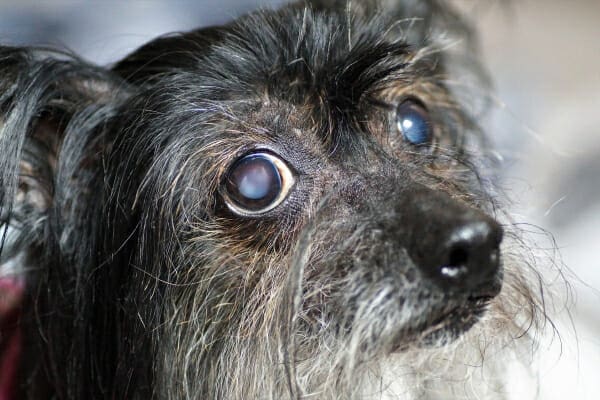
What is the treatment for cataracts?
After diagnosing your dog with cataracts, your vet will discuss the potential treatment options. Sometimes this will simply involve monitoring and more frequent eye exams if the cataract is incipient or early immature. In other cases, the vet may recommend an evaluation with a board-certified veterinary ophthalmologist to be evaluated, or to see if your dog is a candidate for cataract surgery. For dogs with vision loss from cataracts, surgery is the only option for restoring sight.
Cataract surgery for dogs
Cataract surgery is the treatment of choice for dogs with inherited or diabetic cataracts. Since it requires specialized training and equipment, only board-certified veterinary ophthalmologists perform cataract surgery. The good news is that it has a high success rate for restoring vision, as long as the rest of the eye is healthy.
Prior to surgery, the veterinary ophthalmologist will perform some tests to ensure that the retina is functioning correctly. This is critical because if the retina is nonfunctional, the dog will remain blind in the affected eye even after cataract removal. It is also important that diabetes is under control (if present) and there isn’t any ongoing eye inflammation or retinal disease at the time of surgery.
A dog must undergo general anesthesia for cataract surgery. So if you are wondering, “Is my dog too old for anesthesia?” or “Is my dog too old for surgery?” please discuss the pros and cons with your veterinarian.
The surgical procedure
Once the dog is anesthetized for cataract surgery in dogs, the veterinary ophthalmologist will make a small incision into the eye. Then he or she will use a special tool that uses ultrasonic waves to break the diseased lens into small fragments. The veterinary ophthalmologist will continue this process until he or she has surgically removed all lens fragments. This process is called phacoemulsification.
Afterward, the veterinary ophthalmologist will implant an artificial lens. This step is important because, without a lens to focus light, the dog’s vision would be very blurry.
Post-op instructions
After surgery, the ophthalmologist will generally send home a series of topical eye medications. It is important to give these medications as directed because they help reduce pain and prevent infection. Your dog will also be wearing an E-collar to help protect the eyes. While I know it isn’t fun for your dog to have to wear a “cone of shame,” keeping it on is critical to your dog’s recovery and the success of the surgery.
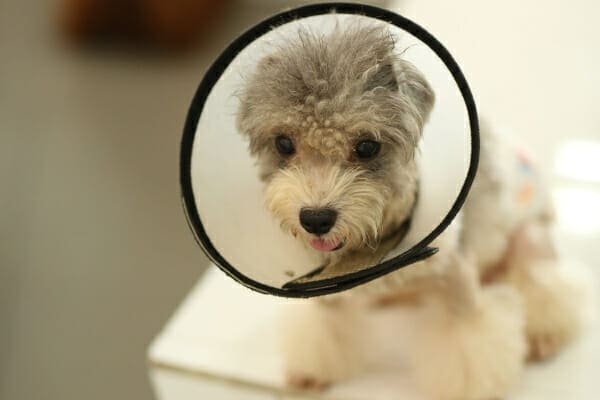
Pros and cons of cataract surgery for dogs
As long as your dog has been thoroughly evaluated and deemed to be a good surgical candidate, cataract surgery can give him back his sight. I can’t think of a better pro for surgery.
The surgery has a very high success rate (90% or more) and usually dogs who have cataract surgery never develop cataracts again.
As with any surgery, cataract surgery has inherent risks. The dog must be under general anesthesia, which may have complications, especially in older dogs or dogs with underlying metabolic conditions (categories into which most dogs with cataracts fall). Although small, there is a risk that the surgery may be unsuccessful and your dog may not regain vision.
For most of my clients, the biggest con to cataract surgery is the cost. Considering the required diagnostic workup, anesthesia costs, the surgery itself (and the unique skill set of the veterinary ophthalmologist who has undergone extensive additional training after vet school), and post-operative care and medications, cataract surgery can cost $5,000 or more.
Realistically, this surgery is not possible for all pet parents. If your dog develops cataracts and you don’t pursue surgery, do not despair! You are not dooming your dog to a miserable life by any means.
Cataract treatment without surgery
While cataract surgery can miraculously restore sight, it isn’t always an option for all dogs. Some dogs may not be a candidate due to underlying health problems or a non-functional retina. In other cases, cataract surgery is cost prohibitive for dog parents. Unfortunately, medical treatment can’t cure cataracts, but it can often keep your dog’s eyes comfortable if secondary problems occur.
Management of cataract complications
Some dogs with cataracts will eventually develop glaucoma (increased pressure within the eye). Others may have episodes of lens-induced uveitis. This is inflammation within the eye which occurs when lens proteins leak out of the lens and trigger an immune response.
Both of these conditions— glaucoma in dogs and uveitis in dogs— may cause pain and discomfort. Some ophthalmologists believe that these eye issues can cause headaches in dogs, though this is difficult to gauge objectively. After all, you can’t ask your dog whether or not he or she has a headache!
If either of these conditions develops, your veterinarian or the veterinary ophthalmologist may prescribe certain medications. Topical and systemic anti-inflammatory meds can relieve pain and discomfort due to uveitis. Dogs with glaucoma often benefit from glaucoma medications to regulate the eye pressure. Because of the risk of glaucoma, ophthalmologists recommend eye pressure checks every four to six months when cataracts are present.
Eye removal
If any of these cataract complications do not respond to medical therapy and cataract surgery is also not an option, your veterinarian may recommend enucleation surgery. This procedure involves removing the eyeball and its surrounding tissues.
While the idea of having a dog who is missing one or both eyes may be difficult to stomach, enucleation often offers your dog permanent relief from eye pain. Considering that most of the eyes that get to this stage are non-visual, the dog isn’t really losing anything except a source of pain when the eye is removed.
Dog parents often remark about how their dog is like a new dog after the enucleation. Plus, since the dog was likely already blind from cataracts prior to surgery, it doesn’t change his or her ability to get around.
Enucleation is much less expensive than cataract surgery, often can be performed by a general practitioner rather than a board-certified specialist, and can greatly improve the long-term quality of life for a dog who is in constant pain from his or her eyes.
What about eye drops for cataracts?
The internet is full of ads for eye drops that claim to dissolve cataracts. However, there are currently no eye drops or treatments that will effectively treat cataracts or will prevent them from forming. So please don’t get fooled into spending money on any over-the-counter drops that supposedly dissolve or prevent cataracts.
How can I help my dog who has cataracts?
Cataracts will cause visual impairment because they block the passage of light through the eye. These seven tips can help you keep your blind dog safe, happy, and confident:
1. Provide a safe and familiar environment
Visually impaired dogs may bump into things or be uncertain in unfamiliar locations. It is important to keep his or her surroundings as familiar as possible and avoid the impulse to rearrange the furniture. That way he or she can remember where to step and what to avoid.
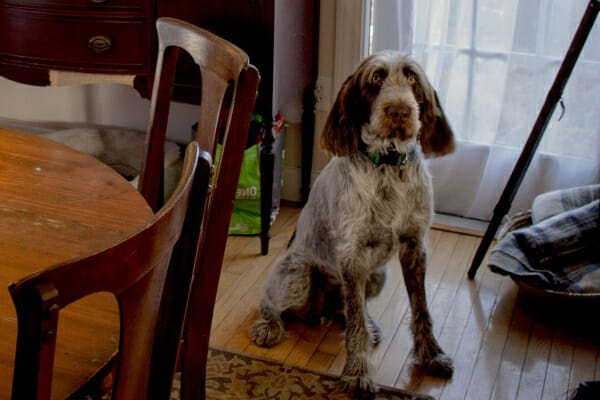
You may want to get down on dog level and look for any sharp corners or other hazards for your dog. It is also a good idea to use safety gates around staircases and swimming pools so that blindness does not result in a traumatic accident.
2. Develop special commands
Sometimes you can teach your dog commands to help him or her know when to step up or jump up. For example, Clark’s foster mom taught him to “load up.” Whenever he heard that command he would trustingly take a flying leap up into the back of her car. She also taught him the word “step” so that he could navigate stairs a bit easier.
Knowing a “stop” or “wait” command is also helpful for stopping your dog before he or she enters a dangerous situation.
3. Make (helpful) noise
Blind dogs also benefit from auditory signals. Clark would follow the sound of the other dogs’ tags jingling on a walk or listen for his foster mom clapping. His foster mom and forever family would talk to him often so he could follow their voices. This also helped him feel more confident in new situations and less likely to be startled.
Additionally, it is important to remember that when you are calling a blind dog to you, you need to continue to call the whole time so that your dog can use your voice to locate you.
4. Use texture as a tactile marker
Blind dogs can also learn that changing textures under their feet indicates something to watch out for. Clark had a rug in front of the staircase so that he could tell he was on the laminate then the rug then the stairs. That helped him know where the stairs were.
You can also put wood chips around the edge of your fence, trees, or bushes to act as an early warning system so your dog doesn’t run into them. Some dog parents will also put a rug at the door (inside and out) to help the dog know where it is.
5. Apply ToeGrips
Additionally, blind dogs can benefit from Dr. Buzby’s ToeGrips® dog nail grips. While slippery floors can be difficult for any dog, they are especially intimidating for blind dogs. This is probably because slipping creates a falling sensation that tends to take away the dog’s confidence. However, with the traction provided by ToeGrips, blind dogs can have a better idea of where their feet are and navigate their environment with confidence.
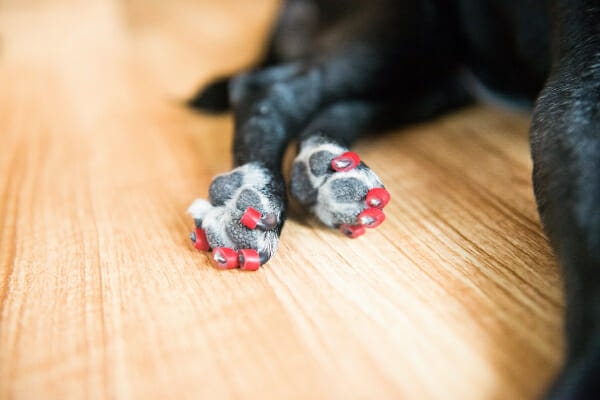
Numerous dog parents have shared how ToeGrips for blind dogs have made a huge difference for their visually impaired pups.
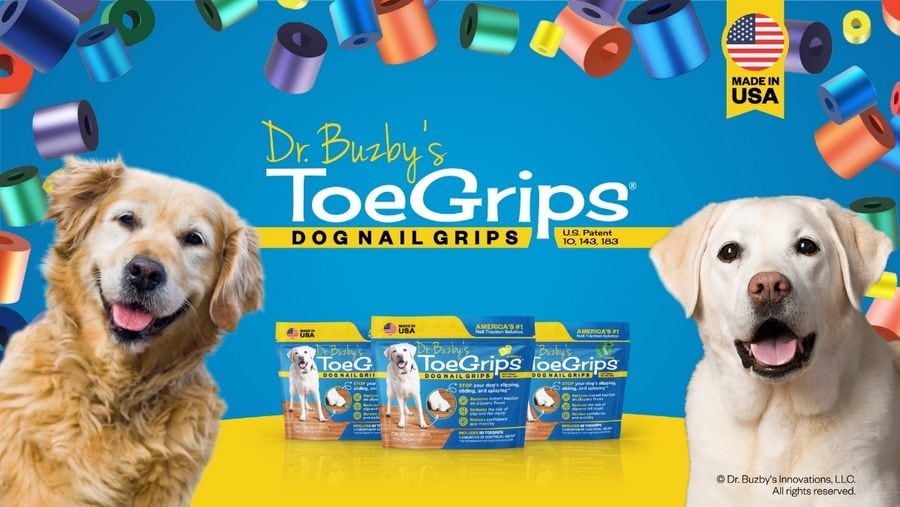
6. Keep your dog safe outside
While I am wary of off-leash activities in unenclosed areas for most dogs, this holds especially true for dogs with impaired vision. While a quick potty break in the front yard may seem benign, a blind dog can quickly become turned around and wander into a dangerous situation. I wouldn’t ever recommend letting a dog with cataracts off-leash in an unfenced area.
7. Seek out helpful websites or books
For more ideas on how to help your blind dog, check out these resources:
- My blog, 7 Tips For Living With A Blind Dog
- The book Clark’s foster mom used to help him: Living with Blind Dogs: A Resource Book and Training Guide for the Owners of Blind and Low-Vision Dogs by Carol Levin
- The book Blind Devotion: Enhancing the Lives of Blind and Visually Impaired Dogs by Cathy Symons.
“The Best Dog Ever”
As you may have guessed based on the things that Clark’s foster mom taught him about navigating the world while blind, he wasn’t a candidate for cataract surgery. The veterinary ophthalmologist suspected that his cataracts were secondary to a condition called Progressive Retinal Atrophy (PRA). This condition occurs more commonly in Labrador Retrievers and renders the retina non-functional. As such, Clark had no chance of being able to regain his vision even if the cataracts were removed.
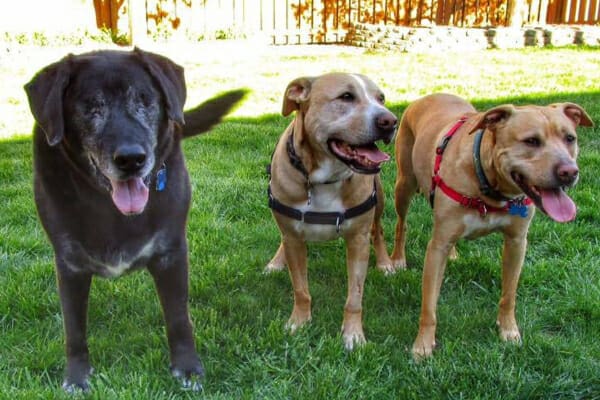
But that never kept him down. His mom described him as the “best dog ever” because he was so happy despite being blind and facing who knows what kinds of horrors in his former life. He greeted every person he met with a big doggie smile and a wagging tail and continued to happily launch himself into the back of the SUV to go on car rides.
Clark loved every dog, cat, and person he met, and they loved him too. He looked forward to his daily Kongs. And of course, being a Lab, he also loved the fact that his parents frequently showered him with treats. If you even touched the treat jar, he would come running from anywhere in the house with a wagging tail.
As his cataracts continued to progress, Clark developed glaucoma. For several years it was well controlled with topical medications, but eventually, the time came when his family thought that enucleation would be the best choice for him. Although his mom said she missed seeing his expressive brown eyes, she didn’t regret that decision because it made him much more comfortable.
When he passed away from cancer, his mom wrote, “I have never had a kinder, sweeter, more sensitive dog. He was such an inspiration to us. We learned so much about life from that old guy!”
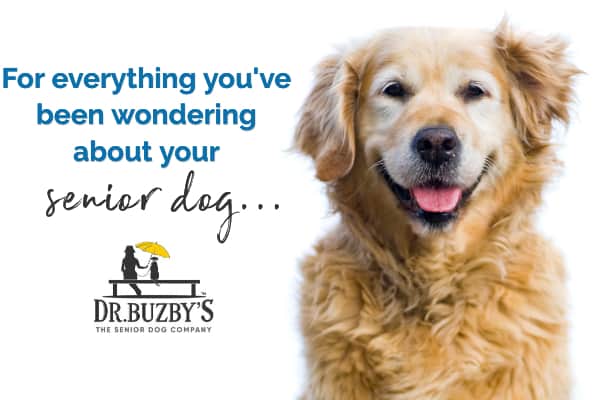
Do you have a dog with cataracts?
Please share his or her story below.


My flat-coated retriever cross will be 15 next month, he has been blind for almost 2 years now. (No reason, there was nothing wrong with his eyes just one day he was blind) He gets around great and has never let it get to him. But over the last month he has developed a cataract in his left eye. I tested his pressures and stained his eyes, but everything came back normal. He’s squinting his affected eye and it has discharge. I fear he may be in pain. Everything online says remove the cataract to regain sight (which doesn’t make sense cause he couldn’t see before) or to remove the eye all together, but with him being so old and myself not being able to afford enucleation surgery are there any other options for hospice? I’m talking with my vet regularly and I am a vet tech myself.
Hi Heather,
I am sorry your boy is dealing with this unknown eye issue. If he is squinting, then I agree this is painful to him. I am not sure what is causing the current problems as it is hard to make specific conclusions without personally examining your pup. I am not aware of any way to relieve the pain other than to pursue enucleation at this point. It is possible his blindness was caused by sudden retinal degeneration/detachment, but of course we may never know for sure. Here is a link to another article with more information: SARDS in Dogs: Sudden Acquired Retinal Degeneration Syndrome
It may be best to ask your vet for a consultation with an ophthalmologist just to find out if there are any other treatment options available that need to be discussed. Hoping you can find a way to restore your sweet boy’s quality of life. Bless you both. ♥
Our 9yo Havanese dog named Lexi had one eye completely covered over with a cataract. It looked like white crystals for the past 5-6 years. Then one day we woke up and it was gone(totally disappeared). I’ve searched the internet looking for answers and found nothing. I had 2 vets confirm both eyes are now cataract free. I have tons of photos of her cataract because it was impossible to hide in photos. Now its gone and her eye seems to be working fine. As confused as we are, she (our dog) must be even more confused. Any info on how this happened would be wonderful. Fingers crossed it never comes back.
Hi Rick,
I agree this is very strange, but what an awesome blessing! I have never heard of anything like this before. Thank you for sharing your experience with us. Best wishes to you and yours.
It’s a miracle!!! You and your dog are lucky! If you have found out what has caused that, as maybe some supplements you have given her for something else, or anything that has changed in It’s life meanwhile, please share! All the best to you and the lovely, lucky pupp!!!
Crying after reading that last bit about old man Clark, my dog is starting to be an old man Sam now and it breaks my heart. He’s been in my life for 13 years now and he grew up with me. I feel that dogs remind us how quickly and temporary life is. Sammy has always been a good dog, even when he puked all over the couch after eating a bag of lindor chocolates. Dogs are such precious creatures, I’m thankful I have had the luxury to provide care and love to my old man Sam.
Dear Olivia,
You are absolutely correct that dogs are precious, and I couldn’t imagine life without them. Wishing you all the best and give Sammy a hug for me! ♥
Wolseley, an 8 year old 9 lb. Yorkshire Terrier, had mature cataracts removed in February 2023. He is diabetic and underwent tests to determine if the procedure would proceed. He proved to be an excellent candidate for surgery. Post-Op, a cone and 7 types of eye drops were administered 4 times a day for 2 months. At present he is on 4 types of drops and will be seen by the ophthalmologist in early May. He is seeing so clearly that we moved his prized treat jar off the kitchen table or else he would stand and look up at it waiting for his next treat. There was an adjustment period of relearning to see again. Wolseley with ongoing owner support continues to benefit from the cataract surgery.
Hi Eileen,
What a blessing this has been for Wolseley and your family! Thank you for sharing your experience with us. I am certain your story will be encouraging and uplifting to others contemplating this surgery for their beloved pup. Wishing you both continued health and happiness. ♥